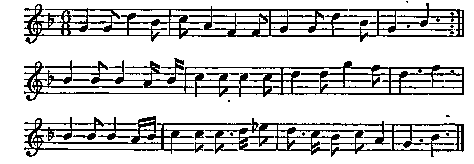Complete Songs Of Robert Burns - online book
360+ songs with lyrics, sheet music, historical notes & glossary.
| Share page | Visit Us On FB |
|
480 |
HISTORICAL NOTES |
||
|
The tune in Walsh's Caledonian Country Dances, c. 1741, is entitled AUister; it is in Bremner's Reels, 1761, 96; and Aird's Airs, 1782, ii. No. iyj. This is the first time that this song of Burns has been printed with its melody.
No. 320. O, leeze me on my spinnin-wheel. Scots Musical Museum, 1792, No. j6o, entitled Bess and her spinning wheel. The MS. of this ideal rustic song is in the British Museum. The description of the little islet is charming with the scented birk and white hawthorn uniting the two branches of the stream across the pool. Ramsay's copy of the English song As I sat by my spinning wheel in the Tea-Table Miscellany, 1725, has not even a distant resemblance to the song of Burns.
The characteristic melody Sweet's the lass that loves me is in Playford's Original Scotch Tunes, 1700, entitled Cosen Cole's delight, and in the Caledonian Pocket Companion, 1753, v. 10, but its extended compass has marred its popularity. Martin Parker, the London ballad writer, wrote Love's Solace to a new Court Tune, or, as in some later copies, ' Sweet is the lass that loves me; a young man's resolution to prove constant to his sweetheart,' to the tune Omnia vincit Amor which does not resemble the present tune.
No. 321. Cauld blaws the wind frae east to west. Scots Musical Museum, 1788, No. 140, signed 'Z.' With tune Up in the morning early; otherwise, Cold and raw. 'The chorus of this is old, the two stanzas are mine' {Interleaved Museum). None of the Scottish collections contain any such song. Burns's model is in the Herd MS., but the subject there is entirely different. The following notes will enable the reader to form his own opinion as to the origin of both the poetry and the music. The anecdote related by Sir John Hawkins in his History of Music, 1776, has been often repeated. In the year 1691 the Queen asked Mrs. Hunt to sing 'the old Scots ballad' Cold and Raw, which she did, accompanying herself on the lute. ' For the Queen's next birthday song Purcell composed, in 1692, an air to the words, May her bright example in the Orpheus Britannicus, 1702, ii. zji, the base whereof is the tune Cold and Raw.' The statement of the historian so far as it goes is quite explicit. Hawkins repeats the anecdote in the light of a tradition, and cites no authority, but he quite confidently asserts the Scots nationality of the air.
Now for some facts: the tune was printed under the title of Stingo, or the Oyl of Barley in the first edition of Playford's Dancing Master, London, 1651, and in every subsequent edition up to the eighth published in 1690. The following is a copy from the fourth edition, 1670, 84.
Stingo, or the Oyl of Barley.
 It was printed in Hilton's Catch that catch can, 1652, as the third part of a Northern Catch entitled Ise go with ye, my sweet Peggy, the last two lines of which are :—
' We'll sport all night for our delight, And go home in the morning early.' |
|||